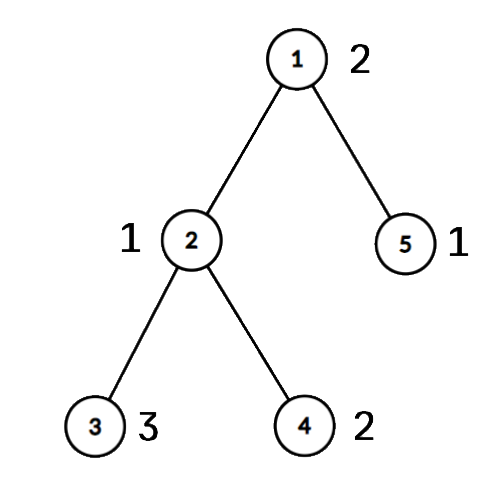CF1805E There Should Be a Lot of Maximums
题目描述
给定一棵树(一种无环连通图)。树的每个顶点上都有一个整数。我们定义树的 $\mathrm{MAD}$(最大重复数)参数为:在树的所有顶点中,出现次数至少为 $2$ 的最大整数。如果树中没有任何数出现超过一次,则认为 $\mathrm{MAD}=0$。
注意,如果你从树中删除一条边,树会被分成两棵子树。我们分别计算这两棵子树的 $\mathrm{MAD}$ 参数,并取两者中的较大值。这个结果就是被删除的那条边的值。
对于每条边,求出其对应的值。注意,实际上并不需要真的删除任何边,每条边的值是独立计算的。
输入格式
第一行包含一个整数 $n$($2 \le n \le 10^5$),表示树的顶点数。
接下来的 $n-1$ 行,每行包含两个整数 $u$ 和 $v$($1 \le u, v \le n$),表示树中的一条边。保证给出的边构成一棵合法的树。
最后一行包含 $n$ 个整数 $a_1, a_2, \ldots, a_n$($1 \le a_i \le 10^9$),表示每个顶点上的数。
输出格式
对于每条边,按照输入顺序输出一个数,表示删除该边后得到的两棵子树的 $\mathrm{MAD}$ 参数的最大值。
说明/提示

在第一个样例中,删除边 $(1, 2)$ 后,任意一棵子树中都没有数出现 $2$ 次,因此答案为 $\max(0, 0)=0$。
删除边 $(2, 3)$ 后,在较大的子树中,$1$ 出现了两次,$2$ 也出现了两次,因此这棵树的 $\mathrm{MAD}$ 为 $2$。
删除边 $(2, 4)$ 后,在较大的子树中,只有 $1$ 出现了两次,另一棵子树中只有一个数,因此答案为 $1$。
在第二个样例中,如果不删除边 $1 \leftrightarrow 4$,那么其中一棵子树会有两个 $1$,所以答案为 $1$。如果删除边 $1 \leftrightarrow 4$,两棵子树都没有重复的数,因此答案为 $0$。
由 ChatGPT 4.1 翻译